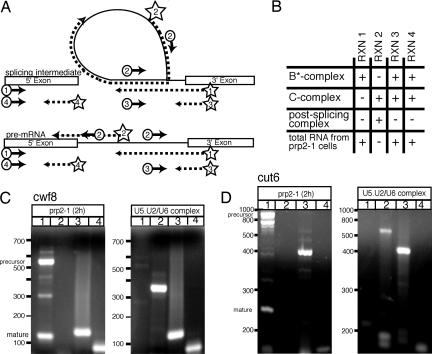Fig. 3.
Identifying RNAs present in the S. pombe U5.U2/U6 complex. (A) RT-PCR was used to characterize RNA extracted from U5.U2/U6 particles. Exons are represented by boxes; introns are represented by solid lines. Positions of primers used in reactions 1–4 are shown in the diagram. Primers used for first-strand synthesis are marked by a star. These primers and/or circled primers were used for subsequent amplifications. The arrows depict the direction of DNA synthesis. The dotted lines represent first-strand synthesis. (B) Summary of PCR amplification products expected in each reaction from different spliceosomal complexes and from RNA extracted from arrested prp2–1 cells. Reaction 1 detects pre- or mature mRNA, reaction 2 detects lariat RNA, reaction 3 detects the connection of the intron with its 3′ exon, and reaction 4 detects the 5′ exon. “+” denotes product expected and “-” denotes no product expected. (C and D) RT-PCR products from reactions probing for the cwf8 (C) and cut6 (D) transcripts in RNA extracted from arrested prp2–1 cells or RNA extracted from U5.U2/U6 particles. Reactions are the same as in A and B. PCR products separated on 3% Nusieve gels and detected with ethidium-bromide.

